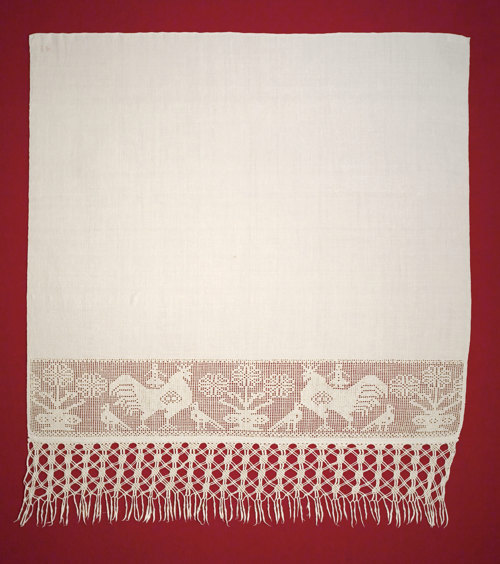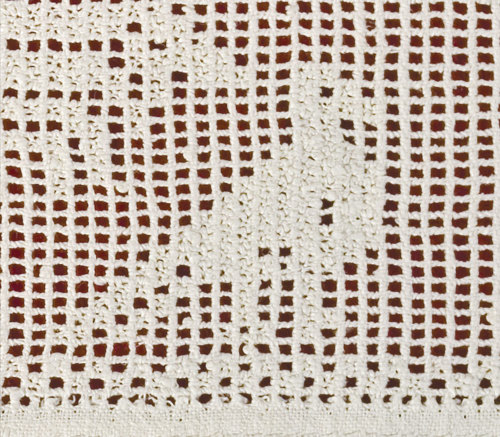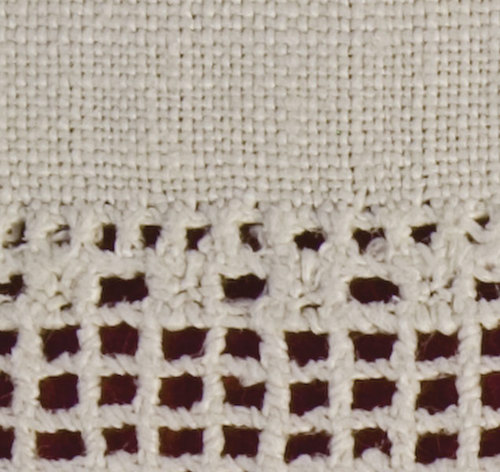Drawn thread work
Here on this page, you will find examples of textiles that incorporate the drawn thread work embroidery technique.

Decorative towel with drawn thread work and plaited warp
The decorative towel is a perfect example of this style. It is made of a large piece of fabric with three borders, with a further two borders attached. The attached top border is identical to the third border. The motifs in the borders are typical, with horses facing each other, reindeers, birds, stars, and a tree of life. Between some of the borders you can see four-sided hemstitching. At the bottom there is an open plaited warp consisting of a plait of three strands. The plaited warp was made separately and attached later.
Please note
- The pattern of the two narrow borders, consisting of alternating squares and stars, is directly borrowed from counted thread work
- The border at the bottom contains the only variation in the decorative towel’s borders by having bars of threads in its trees
- The plaited warp is made separately even though the same quality fabric is used
- The small marks and holes in the fabric under the top border caused by the removal of a monogram



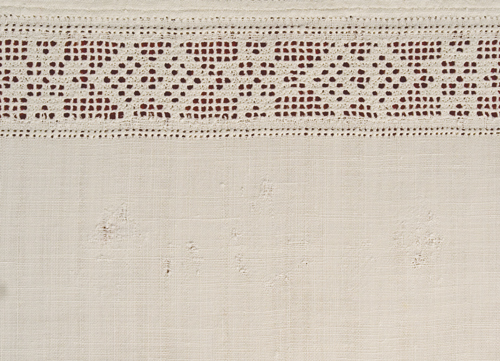
Decorative towel with drawn thread work
Three borders are spread over this very plain decorative towel. In the top border two birds are seen in a row of trees. Whip stitch together with end darning stitch has been used to produce a zigzag pattern above and below the row of trees and birds. In the upper border, darning stitch in circles has been used to show the distinctive leaves or fruits in the trees’ crowns. A monogram, with the year surrounded by a wreath, and a flower arrangement on each side, has been sewn in red cross stitch between the two upper borders.
Please note
- In the middle border the special animal motifs: the double bird and the front part of a horse
- All borders are surrounded by four-sided hemstitch
- In all three borders a combination of whip stitch and darning stitch has been used
- In the lowest border the two outer borders are embroidered with darning stitch which, by the direction of the stitching, makes them resemble the half counted thread work stars, well-known in early Hedebo Embroidery





”Knædug” with drawn thread work
A ”knædug” hung on the pole (“knæ”) for drying socks etc. above the stove. The drawn thread work is exclusively embroidered with interlocking stitch, and appears here in its basic form, filling the motif areas. The motifs are two lions which lay down with their heads facing each other. Between them is a flower arrangement, two birds, and stars. At the sides, one can see how different the patterns are from each other. The needlewoman has mirrored the bird and the flower from the centre motif, but left out the symmetry of the border on the right side. The main motif is framed in two similar zigzag borders, which again are framed by a whipped zigzag hemstitch.
Please note
- The almost invisible monogram in faded red cross stitch, without a wreath or other form of accentuation
- That the withdrawn threads are cut close to the selvage
- The plaited warp is plaited in a wider piece of fabric which has been seamed thinly and bent to fit the width
- The plaited warp is seamed to the ”knædug” with horizontal feather stitching

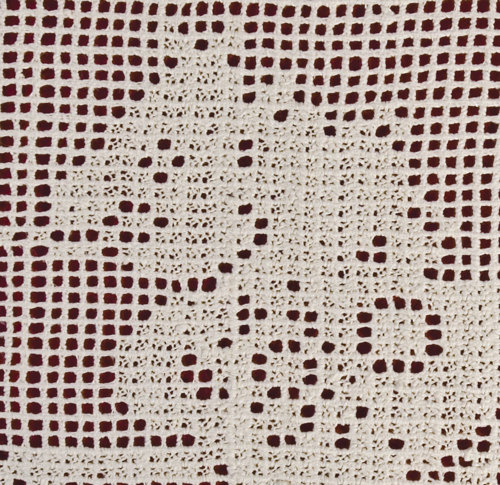


”Knædug” with drawn thread work, counted thread work, and square cut work
The ”knædug” consists of three pieces sewn together. The upper piece is a linen fabric with the initials B and D in cross-stitch. The centre piece contains embroidery in two borders. The upper one is narrow, with square cut work and counted thread work bordered by four-sided hemstitching above and below. The wide border, which forms the main motif, is embroidered with drawn thread work with interlocking. The motif is crowned swans, alternating with flower arrangements and small birds. The bottom piece of fabric consists of a narrow border with a geometrical pattern in counted thread work and a plaited warp.
Please note
- The motifs in square cut work in the top border are whipped at the edge with very unequal long stitches. Is this a part of the pattern, or bad embroidery technique?
- In the two joins of the fabric, herringbone stitching is used to make it look like zigzag hemstitching
- The pattern in the drawn thread work border is not centered
- The middle letter in the monogram has been unpicked
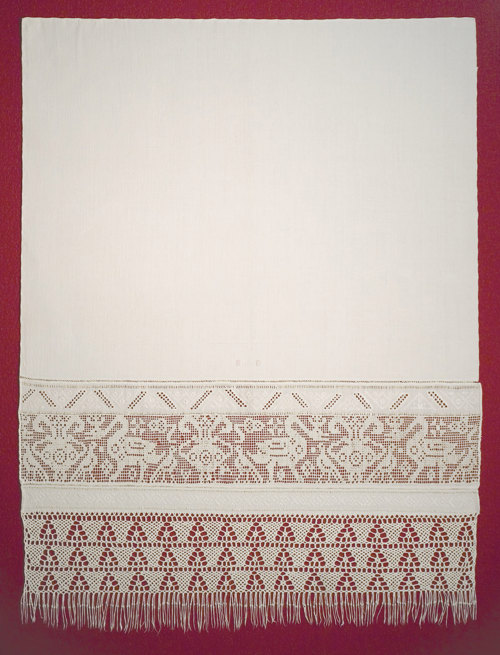



”Knædug” in drawn thread work, counted thread work, and square cut work
The wide border is drawn thread work with whip stitch. The motif is a simple alternation between women with headwear and flower arrangements. Above and below the drawn thread work border are two narrow borders of counted thread work and square cut work. Above the borders is a faded red cross monogram with the initials BID, the date 1839, and a flower arrangement. The drawn thread work border is sewn to the bottom of a piece of fabric. This has been seamed before an open plaited warp, on a narrow piece of fabric of the same quality, was attached.
Please note
- The backstitching around all the small areas of square cut work
- How close to the selvage the withdrawn threads of the drawn thread work are cut
- The stitches holding the pieces of fabric together are made by winding hemstitching, sewn over thicker thread, which spans across the two pieces
- A thin thread is drawn around the small ‘stains’ below the large flowers

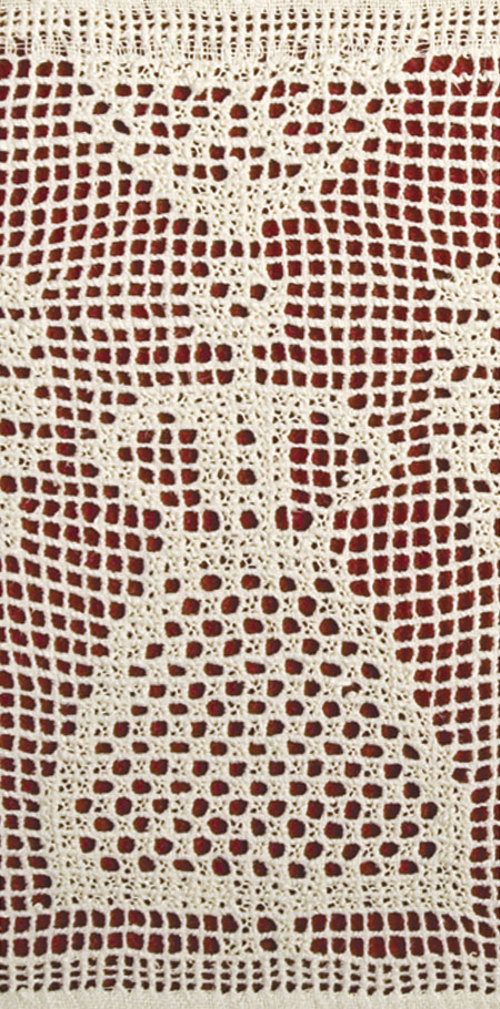




”Knædug” with drawn thread work
Drawn thread work is the oldest form of drawn embroidery. It is characterised by the withdrawal of threads from one side of the fabric to the other. In this drawn thread work, interlocking without variation is used to sew the two face to face cockerels, each with a person on its back, the three flower arrangements, and the four pigeons turning away from the centre. It is uncertain whether the needlewoman placed any significance on the use of these motifs. Many of the motifs used in drawn thread work and square cut work are known from both Christian imagery and that of other religions.
Please note
- The needlewoman repeats the centre motif, which is not finished, on the sides. It is characteristic of drawn thread work that the needlewoman did not count the number of holes available and adapt the pattern accordingly
- The snipped threads are overcast around the cut threads on the sides, with a single stitch in each of the holes
- Hemstitching is used to secure the cut thread above and blow. Both simple finishings have been strong enough to be washed and used
